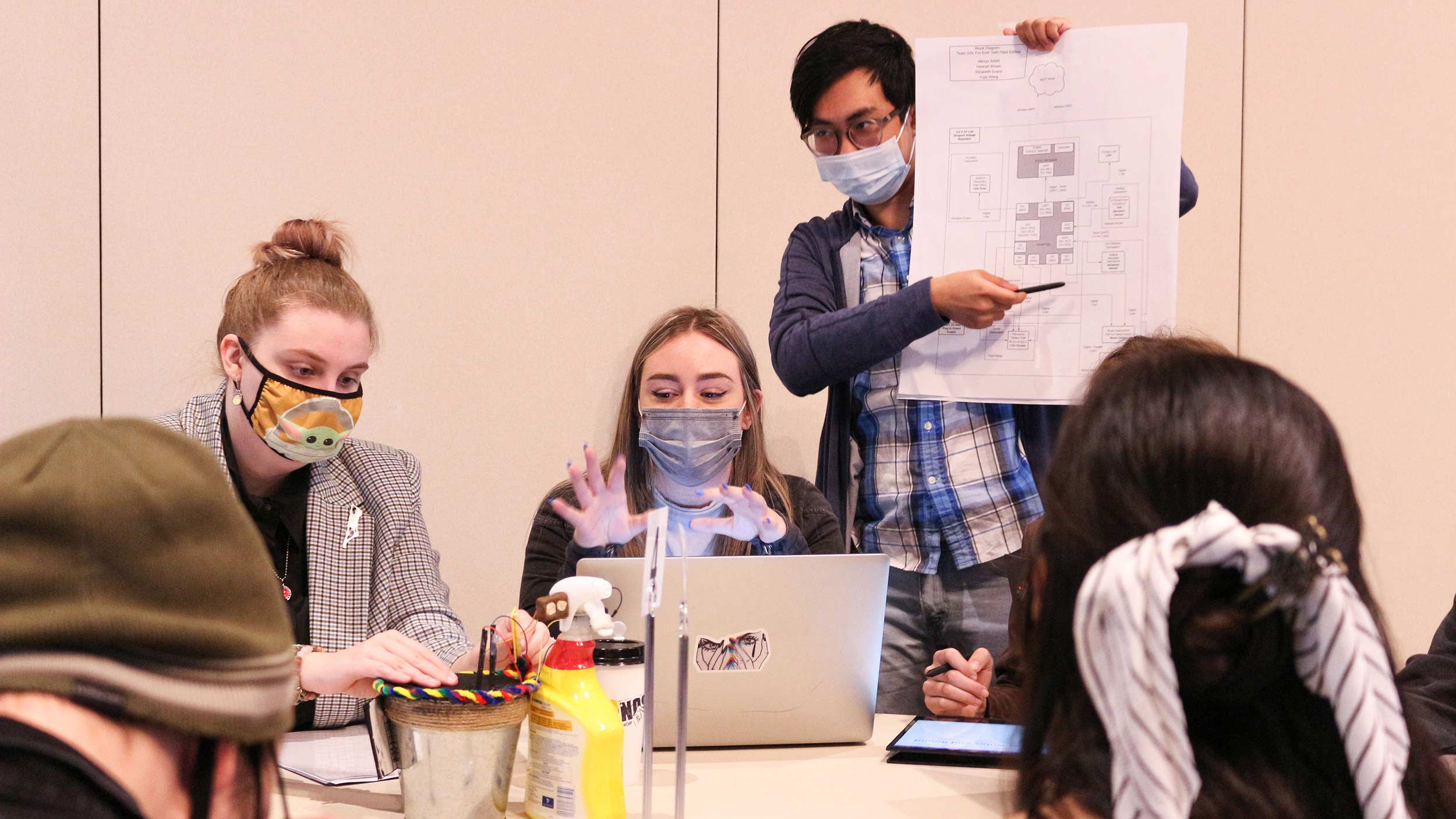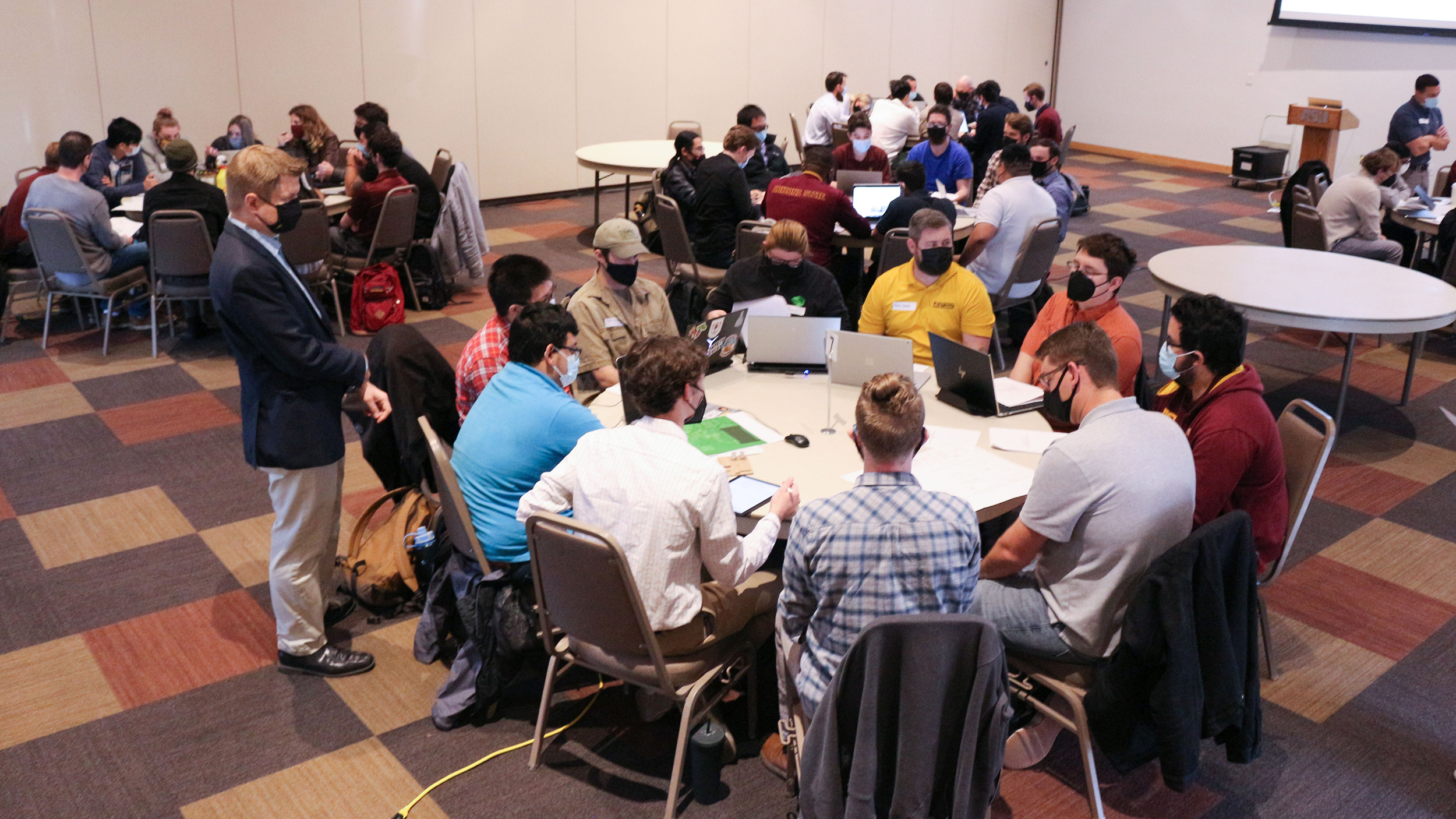
Bringing industry experience into the engineering classroom

Seeing the future isn’t normally possible. However, Arizona State University students taking the Embedded Systems Design Project II course, EGR 314, have the unique opportunity to see what their engineering future holds through mentorship from industry professionals who took the same course as ASU students.
The alumni mentors agree that EGR 314 was one of the most impactful courses they took as undergraduates in the Ira A. Fulton Schools of Engineering — it was where they got their first glimpse into industry practices and gained critical experience that prepared them for real-world engineering.
Taking the initiative to engineer better robotics education
Course developer Shawn Jordan, an associate professor of engineering, was tasked with redesigning the course in 2011 when he first joined The Polytechnic School, one of the seven Fulton Schools at ASU. He saw the impact industry mentorships were making across ASU’s Polytechnic campus at the senior capstone level and decided to implement similar opportunities within his junior-level courses. He now teaches the course with his colleague Daniel Aukes, an assistant professor of engineering.
Each semester, Jordan and Aukes give technical minimum requirements, define a class-wide context — in this case, wearable robotics, selected in part because of Aukes’s heavy research focus in wearable assistive devices — and allow students to take control of defining their own projects as long as they fit loosely within the constraints of wearable robotics. This was “an intentional course decision,” Jordan says, “because it supports students to differentiate themselves on their resumes based on their own interests.”
Jordan and Aukes infuse various research-based educational techniques from the world of gifted education, which focus on offering curriculum for students at different abilities and knowledge levels so all students can grow through an engaging learning environment.
One of these techniques that Jordan and Aukes call an “in-class checkoff” helps students overcome technical hurdles such as connecting to a microcontroller, using an oscilloscope or debugging code for the first time.
“This helps make individual learning experiences, like homework, more focused on learning than technical frustrations,” Aukes says.
They implement these techniques at all stages of the course, whether students are programming their embedded systems, designing their devices or learning how to work together on teams.
“One of the most important aspects of the course is challenging students to communicate and work in teams using modern collaboration technology,” Jordan says. “This helps make everyone successful and ensures they are contributing to their team’s design.”
A cornerstone of the course is the mid-semester design reviews that allow students to present their designs — such as wearable robots in the Spring 2022 semester — to various mentors who are industry members from Intel, Microchip, Texas Instruments, Fender and other major companies with operations in Arizona. Mentors provide students with encouragement, design and structural suggestions and ideas for improving efficiency in format similar to how they would receive feedback in industry settings.

Shawn Jordan, associate professor of engineering, coordinated design reviews for his embedded systems design course enabling industry members to offer new perspectives on student projects. Photographer: Sona Srinarayana/ASU
Exposing students to industry feedback at the junior level offers students a more seamless transition between the junior and senior year “so they are more able to succeed in the capstone setting,” says Jordan, noting a student’s senior year is when they typically encounter industry-sponsored projects.
Design review — a project-based midterm
One of the benefits of the mid-semester design review is that it allows students to integrate efficiency into their designs — something they may not have considered initially.
One of this semester’s mentors is Travis Marshall, an alumnus from ASU’s Barrett, The Honors College who graduated with a bachelor’s degree in engineering in 2014. Now working as a mixed signal electrical engineer at Fender, Marshall challenges students to lean into design constraints and helps them understand the importance of efficiency within their designs.
“I ask questions like, ‘Can you make this smaller?’ ‘Can you make it more efficient?’ ‘Can you make it cost less?’ and offer ideas to support these questions,” Marshall says. “These are questions we ask ourselves as industry professionals.”
After the design reviews, third-year electrical systems major Mike Femiani altered the hardware and coding in his wearable infrared distance sensor to enable better efficiency. His team’s device allows users to automatically survey distances and angles at construction sites.
“This is the closest thing we’ll have to a real-world industry environment,” Femiani says. “It was nice to have access to them and their expertise and reaffirm that this is what it’s like in a professional environment.”
Fourth-year robotics and autonomous systems 4+1 student Sage Furman and her teammates are working on a device that uses sensors to deploy a hood to protect the user based on weather conditions. She is grateful for their mentor’s advice because without it she says they would’ve burnt their entire circuit and would’ve had to start over.
“We were faced with a major setback after the design review, but because prior engineering courses have given us practice in overcoming obstacles, we were able to adjust faster this time and make the necessary changes quickly,” Furman says. “We can leave this class and go into industry with those skills.”

(From left to right) Tyler Hulson, Sage Furman, Michael Reynolds and Aaron Clatone are pictured with their AutoHood that uses sensors to deploy a hood to protect the user from weather conditions. Photographer: Sona Srinarayana/ASU
Industry mentor Wade Adams, an analog validation engineer, began interning at Microchip as an undergraduate student at ASU and has been working there ever since. As a student he says he was exposed to all of the processes that he uses in the field now, from designing circuit boards to making schematics and working with test equipment like oscilloscopes and other measurement equipment.
“This class specifically was probably the biggest advantage I had when I was a student,” he says.
Gil Ruiz’s project benefited from the schematics experiences of Adams and other mentors. Ruiz, a third-year robotics and autonomous systems major, says along with valuable schematics feedback, he was given sound reasoning as to why those changes were necessary. He and his team were able to adjust the schematic for their device that allows users who are visually impaired to have awareness of an object approaching them and of the distance and speed at which it is approaching.
Ruiz, Furman and Femiani agree that having their designs verified by professionals gave them the encouragement that they were on the right track.
Continued focus on experience-based learning
At the ASU Polytechnic campus, evidence continues to support that project-based and experience-oriented learning are optimal for students as they enter industry endeavors.
ASU electrical engineering alumnus Jared Morton is a research and development engineer for Intel and has hired a number of new graduates. He believes that along with the collaboration between students and industry, it’s “the hands-on experience from classes like these that makes them unique and applies directly to the industry.”
Another mentor, engineering master’s degree alumnus Gerardo Rivera, an analog validation engineer at Texas Instruments, agrees that the skills he learned as a student in this course are frequently used in his day-to-day work.
James Larson, a communications engineer at drone startup Toofon, also continues to use skills he learned in the course. While pursuing his engineering degree at ASU, he worked as Associate Professor Shawn Jordan’s research assistant in studying project-based learning. Larson has since been supporting EGR 314 as a mentor.
“The project requirements that the students are designing to are actually the minimum requirements for accreditation as engineers, so many of these students are actually exceeding expectations for what is expected from engineers at this stage,” Larson says. “And by the time they end up in their engineering capstone course a year from now, they’re going to be ahead of everyone who hasn’t taken this class because they have this experience.”
The EGR 314 course will continue to support industry mentorships with goals to expand in the future. Jordan and Aukes plan to include more software and coding curriculum into their embedded systems design course, allowing students to have even more creative control of their projects and, ultimately, equipping them with more skills and experiences they can use to hit the ground running after graduation.
If you would like to be a design review mentor, contact Shawn Jordan.



































